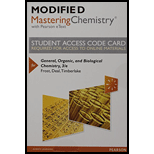
a.
To determine:
If silver ions electroplated into silver atoms corresponds to an oxidation or reduction.
Introduction:
Atoms consist of three subatomic particles namely proton, electron, and neutron. Out of these subatomic particles only electrons are involved in bonding. The formation of a bond between two species always due to the involvement of electrons either it undergoes loss of electrons or gains of electrons.
b.
To determine:
If D-glucose reacting with hydrogen forming D-sorbitol corresponds to an oxidation or reduction.
Introduction:
Atoms consist of three subatomic particles namely proton, electron, and neutron. Out of these subatomic particles only electrons are involved in bonding. The formation of a bond between two species always due to the involvement of electrons either it undergoes loss of electrons or gains of electrons.
c.
To determine:
If the
Introduction:
Atoms consist of three subatomic particles namely proton, electron, and neutron. Out of these subatomic particles only electrons are involved in bonding. The formation of a bond between two species always due to the involvement of electrons either it undergoes loss of electrons or gains of electrons.
Want to see the full answer?
Check out a sample textbook solution
Chapter 5 Solutions
Modified Mastering Chemistry with Pearson eText -- Standalone Access Card -- for General, Organic, and Biological Chemistry (3rd Edition)
- What are enzymes? Name the enzymes required for the fermentation of sugar cane to ethanol?arrow_forwardWhat is the balanced equation for acetaldehyde, CH3CHO, is completely oxidized?arrow_forwardFor the equations below, which molecule is oxidized and which is reduced? H2S + CL2 --> 2HCl + S HS- + 2Fe+3 --> S + 2Fe+2 + H+ Na2SO3 + H2O2 --> Na2SO4 + H2Oarrow_forward
- C12H22O11 + H2O → C6H12O6 What type of reaction is this? Is the lactose to glucose reaction a redox reaction?arrow_forwardAnimal fats and vegetable oils become rancid when exposed to air because a. they are hydrogenated to form saturated fatty acids. b. they form amino acids in air. c. they are partially hydrogenated. d. carbon-carbon double bonds are oxidized in air, producing small organic molecules.arrow_forwardIf a reaction will occur, give the product(s) otherwise write no reaction. Also indicate if the reaction is fast or slow. Explain your answer. 1. Glycogen + I2/KIarrow_forward
- Iodine solution is reddish-orange. When a dilute solution is placed on a slice of bread, it turns dark blue. This is because the bread contains a. sucrose b. cellulose c. glucose d. protein e. starcharrow_forwardWhich is the oxidant in the reactant side for each of the following reactions. Use the change of its oxidation numbers from the reactant to the product to identify it. (a) KH + H2O ---> KOH + H2 (b) 2 KClO3 + 3 C ---> 2 KCl + 3 CO2(g)arrow_forwardRunning a mile in ten minutes burns between 100 and 120 calories for a 150-pound person. For the same run, a 200-pound person needs about 135-155 calories. In grams, how much ATP is required for this workout? ATP has a molecular mass of 507 g/mol. ATP's g-phosphate group hydrolysis has a free energy of -32 kJ/mol. One calorie is equal to 1000 calories, and one calorie is equal to 4.184 kilojoules (kJ). How much glucose do you need to fuel this run, both aerobically and anaerobically? Assume that one glucose molecule yields 30 ATP when processed aerobically. Molality of glucose is 180g/mol.arrow_forward
 Chemistry for Today: General, Organic, and Bioche...ChemistryISBN:9781305960060Author:Spencer L. Seager, Michael R. Slabaugh, Maren S. HansenPublisher:Cengage Learning
Chemistry for Today: General, Organic, and Bioche...ChemistryISBN:9781305960060Author:Spencer L. Seager, Michael R. Slabaugh, Maren S. HansenPublisher:Cengage Learning Chemistry & Chemical ReactivityChemistryISBN:9781337399074Author:John C. Kotz, Paul M. Treichel, John Townsend, David TreichelPublisher:Cengage Learning
Chemistry & Chemical ReactivityChemistryISBN:9781337399074Author:John C. Kotz, Paul M. Treichel, John Townsend, David TreichelPublisher:Cengage Learning Chemistry & Chemical ReactivityChemistryISBN:9781133949640Author:John C. Kotz, Paul M. Treichel, John Townsend, David TreichelPublisher:Cengage Learning
Chemistry & Chemical ReactivityChemistryISBN:9781133949640Author:John C. Kotz, Paul M. Treichel, John Townsend, David TreichelPublisher:Cengage Learning Chemistry In FocusChemistryISBN:9781305084476Author:Tro, Nivaldo J., Neu, Don.Publisher:Cengage Learning
Chemistry In FocusChemistryISBN:9781305084476Author:Tro, Nivaldo J., Neu, Don.Publisher:Cengage Learning





